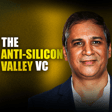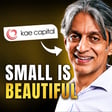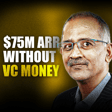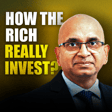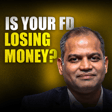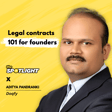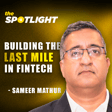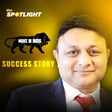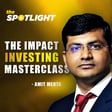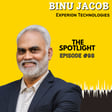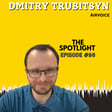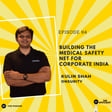Become a Creator today!Start creating today - Share your story with the world!
Start for free
00:00:00
00:00:01

Sahil Anand (Cedar IBSi Capital) on the massive B2B Fintech opportunity
In this episode, join Sahil Anand, founder of Cedar IBSi Capital, as he shares his entrepreneurial journey, exploring the evolution of Cedar Consulting and the unique challenges of launching a fintech investment fund. Learn about the consulting landscape, Cedar's execution-heavy approach, and the promising future of fintech in India.
Akshay Datt, a serial entrepreneur having run ventures in Employability Training and hiring, is the host of "The Spotlight", presented by the Founder Thesis podcast. He has interviewed 500+ founders to date.
Connect:
Sahil Anand: https://www.linkedin.com/in/sahil-anand-0669a689/
Akshay Datt: https://www.linkedin.com/in/akshay-datt/
Founder Thesis: www.founderthesis.com
Transcript
Introduction and Cedar Capital's Origins
00:00:00
Speaker
Hello, everybody. My name is Sahil Anand. I'm the founder and managing partner at Cedar Capital.
00:00:19
Speaker
So, Sahil, welcome to the Founder Thesis podcast. I want to go back a bit before we talk about Cedar Capital now. you know, let's kind of start with the consulting business, which is Cedar and IBSI and give me like a little history on that business.
Growth and Expansion of Cedar Consulting
00:00:40
Speaker
Your father is the one who set those up. but so So just give us some context on that. Yeah, sure. So, um cedar Cedar Consulting is actually the, so as to say, legacy business.
00:00:57
Speaker
Very unique situation actually, we're probably one out of… He'd be like 10 family-owned management consulting businesses in the world. Maybe not even 10, maybe 5. um ah American consulting firm, about 40 years old.
00:01:12
Speaker
ah My dad joined them in the US, in Chicago, after his MBA. And um just like any consultant, he worked on many projects and he grew um the ladder.
00:01:26
Speaker
um And in the early ninety s is when um his boss, um yeah two bosses, one in the UK and one in the US basically requested him to move to India um to set up, which was at that point one of India's only early consulting practices because consulting was still kind of new phenomena in this part of the world.
00:01:50
Speaker
um And our traditional family business was actually for pharma and medical devices. We made like thermometers and blood pressure monitors and all of that. But like your grandfather said that. Yeah.
00:02:04
Speaker
Yeah. ah Well, yeah. Believe it or not. I mean, he had that business, but my grandfather was also an ODE consultant. So my grandfather was a um He was a OD consultant. He ran ah consulting firm called Anand Associates.
00:02:20
Speaker
oh Maybe be like a 5-10 man consulting firm. Did a lot of consulting work for the old... Indian family businesses, be it the Godrages or the... In fact, I wrote to Mr. Narayan Murthy using my grandfather's name a couple of weeks ago because I wanted an introduction to his family office.
00:02:36
Speaker
And he was kind enough to reply immediately. Literally three minutes he replied, saying that, yes, of course, Dr. K. Kyanan and then I used to roam around the I.M. Ahmedabad campus in a golf cart ah doing a tour because my dad was a founding faculty of I.M. Ahmedabad.
00:02:53
Speaker
So my my grandfather was actually also quite consulting oriented, ran a consulting practice, i was a professor, all of that. um I forget how we had this medical device business, but the reality is nobody was interested in it.
00:03:06
Speaker
And so what what happened is we set up, my dad set up Cedars India practice in 91, 92. And
00:03:15
Speaker
at that time, the consultants often played the role of kind of being consultants and investment bankers, right? Because they were basically just advisors. And so I think the first 20, 30 mandates we did as CEDAR in India um was more just like um a little bit of everything, right? Some P.E. advisory, some due diligence, some M&A, some strategy design.
00:03:39
Speaker
um And then maybe five or seven years later in the early almost 2000s, maybe late 90s is when my dad realized that he was really loving this and that he had done ah well for himself in terms of building a practice from scratch, both in India and in the Middle East.
00:03:56
Speaker
So he started the Middle East practice in 97 or 98. Again, one of the earliest consulting firms to go to the Middle East and there was nothing there 25 years ago.
Cedar's Consulting Approach and Strategies
00:04:06
Speaker
um And he went back to his boss,
00:04:11
Speaker
um Tom Rump and John Moulton, these two gentlemen, and said that, hey, listen, um I'd like to buy the practice, right? And then at that time he obviously could not afford to pay them at one go.
00:04:28
Speaker
Because my, my, my. By the practice and by the India practice. No, by everything. um but what they yeah But what they agreed, what they agreed is that. How big was the business?
00:04:42
Speaker
Revenue, I would not know to be honest, but there must have been about. 35, 40, 45 consultants. So like a boutique consulting firm, right? Not very big at that time. And this was... But doing the same work as let's say a McKinsey or a BCG. Yeah, yeah. Same work.
00:04:58
Speaker
Same work, but under a different brand name. So that time the brand name... um We operated under a brand name of Renaissance Worldwide in Technomic Asia out of Chicago. So basically what happened is Cedar is actually a spin-off of a larger consulting firm and that was headquartered in Chicago that broke up into 8 or 10 firms.
00:05:19
Speaker
And Cedar is one of them. um And and and then this would i like ah typically consulting firms have partners. Yeah, so there were about five or six partners.
00:05:32
Speaker
Some of them still work with us. Steve Raisin is with us and Greg Kirish is with us. And um yeah, so there are people who've been around for a long time. um At that time, we didn't do much financial services, right? So at that time, Cedar was kind of doing everything. We did, I don't know if you've heard of Radio Shack in the US, one of the America's large retailers when it came to electronic devices. And and yeah so we we Radio Shack turned around, retail strategy was an example of a client. Sarah Lee was a client. Kellogg was a client.
00:06:01
Speaker
um Multiple Japanese companies, as I told you in the past, our clients because we had a small office in Japan. um in India, we had the Piramal family by Gujarat Glass, right, which then became Piramal Glass, which is what it is today, which they've sold and further on,
00:06:18
Speaker
um Gullu Metschandani who runs Onida, his son Sasha is obviously now well-known, but he was a client. And so actually 80-90% of the client base was non-Fin.
00:06:34
Speaker
Because the core expertise was using the balance scorecard, which is like a measurement framework to drive ah performance. um Because Professor Kaplan, who founded the balance scorecard as a concept at Harvard Business School, ah was one of these gentlemen who created Renaissance and Technomic and the old Cedar.
00:06:55
Speaker
right So what happened is a lot of his IP flowed through the consulting work week. And so I think even today as a consulting firm, probably one of the only consulting firms in the world and maybe done 600-700 scorecards, right? for In every industry for a client. What is this balance scorecard?
00:07:14
Speaker
Give me a 101 on that. Yeah. So the balance scorecard is basically a… um It's a… very detailed performance management framework um that breaks up the a strategy of any business into a sort of a Google map and it's very directional.
00:07:35
Speaker
It has four or five dimensions ah around financial goals, customer goals, product goals, organizational goals, process goals and basically through a very ah dynamic process with the top 20 people at an organization ah over maybe three to six months.
00:07:56
Speaker
um ah We would basically understand what the priorities of the business are. and and and and basically tie everything together um taking all 20 leaders points of view into this straw model that is called the balanced scorecard.
00:08:14
Speaker
Where very quickly on a one-pager you have your 405 financial KPIs and your operational KPIs and it's basically meant to fast track performance um and often a lot of clients Cedar does this work for We'll print it, laminate it, have put it in the drawers of all their CEOs and executive ah well leaders of their CXOs. And it becomes a very efficient tool to just know what are the 10 objectives across four dimensions um to get to X revenue. So we recently did this for when I used to work in CEDA because obviously before the fund, I was doing um consulting and IBS intelligence, which is the second business.
00:08:56
Speaker
me oh we had a footwear Indian footwear company, a well-known Indian footwear company ah that's competing head-on with Bata that is currently in that 1,200-1,300 crores of revenue, ah wants to get to that crores of revenue, which is where Bata is at.
00:09:16
Speaker
And basically we spent three to four months with the family that owns the business and the 10 leaders on kind of designing what the objectives are across these dimensions or to accelerate performance and go there.
00:09:28
Speaker
And a lot of it, as you know, in consulting is also about the execution of it, right? So I think the other big thing about Cedar is that we've been a very execution heavy consulting firm throughout. A lot of consulting firms, especially the bulge bracket ones were doing more design and kind of getting away with just kind of doing the front end strategy design and charging heavy amounts of money for that and then leaving out the implementation to the client.
00:09:53
Speaker
I think the big trend in the industry has been um clients basically waking up and saying that they're not going to just implement stuff that um a consulting firm has given them and that the the consultant needs to live with them through the process.
00:10:08
Speaker
So actually Cedar's tagline is we make strategy work because a lot of Cedar's work is actually execution heavy. So 8 out of 10 clients will do design and we will live with the client for 6, 10, 12, 15 months on the implementation.
00:10:23
Speaker
So similarly, we lived with this footwear company for six months later, where we said, okay, these were the objectives, this is how they would become 3000 crores. And now here are the 10 tracks of work that need to happen, right? So SKU optimization needs to happen, better retail strategy needs to happen, all transformation needs to happen.
00:10:38
Speaker
And then those become smaller mandates, three month mandates, right? and but But they basically execute and deliver the original goal of the balance scorecard. um So yeah your consultant would look at the SKUs and would be advice on how to rationalize the SKUs. Yeah, the only thing we don't do is we're not like, ah there's a couple of things we don't do, right? So we're not like, um oh we're not like heavy, heavy operational excellence consultants. So we won't get into like process. We'll do process design at a high level.
00:11:13
Speaker
But we won't get into like how Kaizen should be defined in your factory and then how are the metrics looking and we won't go into that level of detail. It's more strategic. um We don't do any like financial due diligence or accounting, any of that kind of research.
00:11:27
Speaker
ah We don't do M&A, so we're not like your investment bankers, we're just strategy consultants.
Tech and Fintech Focus at Cedar
00:11:32
Speaker
um And... One question said quickly I want ask. the Yeah. Buzz bracket consultants. So buzz bracket means what? Like the the big names like BCG. Yeah. So we can compete.
00:11:43
Speaker
Yeah. So we compete ah two types of consulting firms, I guess. We compete with McKinsey, BCG, Bain. And called bulge brackets. Yeah, they're called MBB. What's the origin of this term?
00:11:55
Speaker
Bulge bracket. Bulge bracket is just, the aid the term was born in the investment banking world where the top four or five investment banks globally that were doing ah the majority of the deals in the market were called bulge bracket. And so anything with the anything with that size or scale that gobbles up a lot of the deals or does a lot of the work is bulge bracket.
00:12:18
Speaker
In consulting, it's obviously the big three firms, right? Which is MBB, which is McKinsey, BCG and Bain. um BCG doesn't actually do much in our space. ah BCG is more other industries, FMCG, consumer.
00:12:31
Speaker
But you're also consumer, right? Like this footwear is... No, what happened is, yeah, so what happened is then fast forward, last maybe 15, 20 years, right, I'd say.
00:12:42
Speaker
oh
00:12:45
Speaker
80% of our practice because as a boutique you need to have some sector expertise, right? Because then clients are like, how can you do the same width of work that a McKinsey can do, right? And so what ended up happening is... um About 80, 70, 80% of the practice has become financial services oriented. Globally, about 60% of management consulting is in any case financial services and because of the money spent on that industry, right?
00:13:11
Speaker
And so I think we've ended up just following that trend and building a lot of good work for a body of work in that space. So today about 80% of what we do is financial services. um Probably done work for maybe like 200-300 banks, 400 banks maybe in this part of the world. Most of our practice today is ah Asia, Europe, Middle East.
00:13:34
Speaker
That's like the big chunk. We do some work in the US and all, but to be honest, it's become more this part of the world.
00:13:41
Speaker
And yeah, so we do two types of work. We either do um business, transform what we call large scale business transformations, where our client is somebody from business.
00:13:51
Speaker
So the CEO or the board all the head retail, corporate, commercial. um So there's not always a tech orientation to those mandates. Often there is because now everything has tech, but they're more to kind of drive business, right?
00:14:08
Speaker
We just led the merger of a very large India's biggest bank, wly which merged with an asset management company that's been around for a really long time. ah So that's something we would have done that's more strategic and business transformation oriented.
00:14:21
Speaker
um And then the second big piece of work we do for banks and financial services is on the tech side, where we get hired by the CTO, which is the chief technology officer or the chief digital officer or the CIO.
00:14:36
Speaker
And we get brought in to basically look at the fintech strategy or the IT strategy of the bank. So we first do typically as a three to six month kind of analysis of where they are. What do other banks do? What kind of technologies are they using? and and and so And then we kind of help them, right? the um So yeah, so we've become our brand reputation now is very, very strong on everything financial services.
00:15:03
Speaker
And that's where we really win. When I say McKinsey and Bain, it's hard to beat them and to be honest, some of the other industries. ah But financial services, we beat them regularly. We lose to them regularly, but we also beat them regularly.
00:15:19
Speaker
um And then whatever we do on the non-Fin side is um so It could be a chemical company, could be a plastics company, it could be a shoe company, but very, very strategic, right? We are going in for this surgical six-month project on this and this and and balance cocared execution and everything.
00:15:41
Speaker
We're doing something for a large ah Italian fashion brand right now, which is one of the world's top 10 brands ah competing head on with LVMH on just an all transformation because the family has left um the grandsons with the team ah that may ah not have all the skills, right?
00:16:00
Speaker
And so, ah so, when very... good of You talk to who you're competing with, you said on one hand, so that business transformation business is competing with McKinsey, NBCG.
00:16:11
Speaker
The technology consulting is competing with like an Accenture Infosense or? Yeah. Not Infosys really because Infosys is often the vendor. um Infosys Consulting does some work but again they do more techy work so Infosys and Tech Mahindra will do more like implementation type of work.
00:16:30
Speaker
They won't do strategic consulting and often their their arms are implementing their own technology, right? um Yeah, I would Accenture, I would say the big four do a lot of this kind of work also.
00:16:42
Speaker
McKinsey does a lot of it, um even on the tech side. There are a few other boutique consulting firms like AT Kearney, Rollen Berger, Oliver Wyman.
00:16:54
Speaker
There's probably about 506 that do FS technology. ah Because to be honest, that's where also you make a lot of the money. Because if the bank is spending like $5 million dollars on a piece of, well, not even, maybe even $10 million dollars on a piece of technology, then they're definitely paying their consultant well enough to make sure that that $10 million dollars gets spent well, right, of the tech.
00:17:19
Speaker
um and And I think the other thing that's been positive is that it's been ah COVID and recession and everything else proof in the sense that while all this unfortunate stuff has been going on in the world, the one thing that didn't stop, in fact, accelerated was this whole spend on tech and digital transformation. And so I think it ties in well with that as well.
00:17:40
Speaker
Which is a bigger part of your business? Tech consulting or business transformation? I would say the tech consulting is a bigger part of the business, but not bigger by that much. Maybe 60, 40. Yeah.
00:17:51
Speaker
Okay. ah
00:17:54
Speaker
And then we bought this research company in the UK in 2015, right? Because we realized we're doing so much tech consulting that it would be nice to have our own like machinery of generating research internally so that we're not dependent on kind of subscribing to external research.
00:18:11
Speaker
So there was a gentleman in the UK by the name of Martin Weibrau. who founded this company in 1991 in London called IBS Intelligence. um IBS stands for International Banking Systems.
00:18:25
Speaker
So basically, the brand he built is very strong on research on FinTech and BankTech and B2B and financial software, right? And so we bought that company in 2015 and that company has become a very important part of our portfolio because on one end now we have the consulting um piece which advises banks and then then on the other end we have this research business that advises fintechs or tech
Pricing Strategies and Challenges
00:18:53
Speaker
companies. right So Infosys is a client actually on the IBS intelligence side.
00:18:58
Speaker
Oracle is a client on the IBS intelligence side. and There will be 300 or 400 global tech companies that are clients on the IBS intelligence side. And so we ended up in this very unique place in the middle. Not many consulting firms globally own research companies as well. There's only maybe one other example I can think of at this point, which is ra um which is Oliver Wyman am and and and CELENT. C-E-L-E-N-T is a well-known research company and they're part of the same umbrella.
00:19:27
Speaker
But that's very powerful. I want to understand the business of consulting a little better. Okay. What is the... How does pricing work?
00:19:40
Speaker
Is it like a very standard thing? Like per hour, per man hour, this is our price. How do you figure out how to price it? Yeah, I think... Yeah, so I think that's what's distinguished... um um like body shopping firms or very implementation heavy firms from strategy firms.
00:20:02
Speaker
um
00:20:06
Speaker
Without, I guess, naming them, there are firms that will just like on a slide on their proposal slide will just say that we give you three senior consultants and two consultants and four analysts and their billing rate is X per day. And therefore, it's very mathematical, like the whole process.
00:20:21
Speaker
um But that's obviously not the The number of mad days into the rate is the bill to And that's the thing. So that's just providing people right at the end of the day. I think true strategy consulting firms obviously um price basis, the firm's IP and what the firm brings to the table as your key consultant. And then okay, people's pricing is obviously built into that.
00:20:43
Speaker
Um, but yeah, it's, it's, it's, I would say it's science and art. I would say the base model typically gets built with just how many partners and principals and engagement managers and consultants do you need and what is their billing rate and what is the OPE because travel is a big part of cost, right? What is no matter what, OPE is like operating expenses outside, like extras basically, um, traveling to client and cost related to being on client site and all that stuff.
00:21:11
Speaker
Um, and but But I would say like 30, 40, 50% of it is just what the firm brings as a um as a leader in a certain domain.
00:21:22
Speaker
um And there's no right way to price that to be honest. I would but i mean i would not be able to define it. Obviously, the implementation is obviously um more is generally priced um um ah more high than strategy design.
00:21:42
Speaker
um Strategy design is typically a more margin because your people are just sitting at their desk. They may be doing one or two trips and they're giving you your output. Whereas on the execution side, Monday to Friday, they're on international flights coming to see you and spending time in your office.
00:21:58
Speaker
um The execution piece is more skin in the game kind of pricing. So if your client achieves X, then the consultant on top of the base consulting fee, you get paid X. It's milestone based sometimes and clients like that.
00:22:11
Speaker
because they can realize the output together. um so With this company example that you give me, this was like a base plus a output base. ah Yeah, this was some output base of them getting to a certain amount of crores in extra revenue in the quarters we were there.
00:22:30
Speaker
um But that was a very small piece of the but the price. That's not a normal model to be honest. I think consultants are moving towards that model but it isn't the norm. And how much would that engagement roughly have been? Like this footwear engagement for these like said. Yeah, India. See, India has always had this pricing challenge, right, for consulting because obviously the attitude.
00:22:54
Speaker
um often is that we kind of pay for advice yeah that and that if you don't understand the profession then your approach is that no we just hire people and fix it do it ourselves right um and so what's the ballpark pricing like for this like say the six month engagement with this photographer I would say like, ah yeah.
00:23:14
Speaker
So I would say like a design piece of work, just design, maybe lasts about three to six, ah three to four months, three to five months. Maybe $100,000, $150,000, $200,000. Execution can because depending the number work streams,
00:23:27
Speaker
two hundred thousand dollars um and like you shouldn't go asleep because depending on the number of works streams the
00:23:37
Speaker
$700,000, $900,000 depending on the amount of work you're doing and how much work you're doing and how much time is spending with the client. um But generally expensive, right? Which is why there's no consulting um um business that works for startups in that sense, so young companies, because so consulting services are typically expensive, right?
00:23:58
Speaker
um ah Which is why I also think And to be honest, we've tried in the past saying, a but three, four years ago, saying that, oh, India has so many startups. Let's do a small consulting practice with a nimble team that can do consulting for young companies.
00:24:14
Speaker
But it doesn't work, right? Because the economics just doesn't make sense and the company's at a completely different stage. And I think what suits that stage of company better is just having the advisory type model, right? Where these subject matter experts just become advisors to startups.
00:24:27
Speaker
And that works well. I've spoken to lot of folks who had a similar idea of consulting for SMEs and with those businesses. SMEs is fine. SMEs you can definitely do work for like if you have a 200 crore or 100 crore company and you can definitely um afford a crore or two or three or four of consulting work.
00:24:46
Speaker
What I mean by startups is like if you're doing like 20 lakhs a month as a startup and you're hardly doing a crore of revenue then it's like um and and yeah so and then the PE guys or VC guys who own them are also not happy about the fact that those young companies are spending money on consulting because That's not the stage they're at, right?
00:25:04
Speaker
And typically, VCs act like consultants, right? but Yeah, and VCs act like consultants and they try to bring a lot of that knowledge and so it's never made sense.
Consulting Economics and Global Operations
00:25:14
Speaker
So, yeah. So, our focus is just large corporates and banks.
00:25:17
Speaker
What are the levers of growth for a consulting business? but Is it about adding people or is it about demand generation? You know what? Yeah, no, it's so it's just adding people, unfortunately.
00:25:30
Speaker
I think that's the challenge with most consulting practices globally. There are three types of consulting firms, right? there are um There what they call small consulting firms and small consulting firms, the global definition is like a five or 10 man shop, right?
00:25:44
Speaker
One or two partners and four or five others, right? ah And there are probably a a couple of hundred of those around the world, right? That do meaningful work. and Then there are medium-sized consulting firms.
00:25:56
Speaker
Medium-sized consulting are maybe 50 300, 400 man consulting firms.
00:26:01
Speaker
consulting firms maybe 100 to 300, 400, right? That do 10, 15, 20 partners and then they all there have their teams and then there are obviously the larger ones, so bul what I was calling bulge bracket ones.
00:26:19
Speaker
But unfortunately, the biggest ever is people because um the more partners you have, ah the more work you sell. And therefore, the more work you deliver and therefore the larger the rest of the organization needs to be. So everything is very partner driven.
00:26:33
Speaker
um And so um and it's it and therefore it's an expensive way of growing. right it says It's an expensive way, but more importantly, it's a slow or gestation way of growing.
00:26:44
Speaker
Because every partner needs to have his own success, they got to get into the firm, they got to learn your culture, they got to work with all your people, client has to trust them and so the way consulting firms have typically grown is they've identified a new country, they've hired four, three partners or two or three partners for that office.
00:27:05
Speaker
They've set up the office being led by two or three new partners who've then hired their teams, who've then gone and looked for clients. um and So I would say it takes three two, three, four years for any consulting office in a new country to really kick off. um So, yeah, so it's it's unfortunately only people, nothing else.
00:27:28
Speaker
The term partners here is a designation or is it a, like a legal standing that you are partner? No, it's a designation. It's a designation in the very large firms that have maybe be four or five hundred partners, thousand partners.
00:27:43
Speaker
and There it's also legal in the sense that they all have tiny amount of equity. Very tiny. McKinsey, BCG are essentially owned by employees in a way. In a way, a small pool is owned by them. um And they have to put money in the firm personally. So they're not just partners like that. So when they get to a certain level, ah bunch of their savings basically, they have to buy their stake.
00:28:08
Speaker
Okay. And they buy into the pool. ah Just like it is also at a law firm or in a tax advisory or accounting firm. But there are also models um where um it's a very notional pool and it's more just about the designation.
00:28:27
Speaker
And then they get paid really well. Yeah. Okay. like Like, who who owns it's like a BCG or a McKinsey or a BIN? The majority is saying? Yeah, it's just Are these publicly listed?
00:28:39
Speaker
Just... No, consulting firms consulting for struggle to get publicly listed because the thing is that everything is so spiky, right? There's no... um um ah There's no fixed trend or a fixed predict like trajectory you can take because every year you start at zero. That's the reality.
00:28:58
Speaker
You really start at zero. You can do exceedingly well in one year, but then your projects end for the year. Some of them spill over. ah But then in January of 2025, you basically start at zero again, right? So how do you value such companies?
00:29:12
Speaker
um And how do you kind of, kind of what do you buy into really? Because you're just buying into... ah new potential projects or projects that may be ending and so generally they aren't they aren't public unless they have a large tech business within them where they're creating their own software like an Accenture for example or an Infosys which is not valued because of the consulting, it's valued obviously because of the tech company but otherwise generally ah consulting firms don't go public. yeah so So like McKinsey is owned by current and previous partners.
00:29:43
Speaker
Yeah, that's basically how it is. I would not even be able to tell you how Bain is owned or who owns Bain. I would Google it myself because it's just maybe 1,000, 1,200 partners. ah Yeah.
00:29:56
Speaker
What kind of revenue does Cedar do? like Cedar has about, um yeah, we're about 250 consultants between Bombay, Bangalore, Cairo, Dubai, London, and New York.
00:30:13
Speaker
And, yeah, we do maybe 200-300 mandates every year, ah heavily focused on, as I said, financial services. And what we did well, I think, over the years is my dad built a practice that had a lot of dollar revenue because he realized early on that the Indian market wasn't going to pay, especially in the ninety s Right, because he basically moved here after selling consulting work in the US and realized that hey listen these Indian clients are not going to value us at least today.
00:30:43
Speaker
And so he very quickly built a Middle East practice and and so I think we're well hedged in that sense and we're not dependent on India revenue and therefore we're not desperate for India revenue or India clients.
00:30:55
Speaker
But to be frank we don't really chase any India clients because we know if we spend the same energy chasing a Middle Eastern client it's like 4x the value right, 5x the value. ah So India work we do very, very selectively.
00:31:08
Speaker
um But it's getting better, right? Obviously now as Indian family businesses are hiring professionals, many of whom are ex-consultants, the value for our profession has obviously grown significantly and everybody values having but consultant.
00:31:25
Speaker
um But there are also clients who are just like, in the middle of the project this disappear a new one you know hard is it's just a bit of that culture still stays. ah Is there like a issue of bad debts here like clients not paid?
00:31:45
Speaker
It's just clients not ah
00:31:51
Speaker
I'm not saying clients are not paying. It's just that clients are not respecting the scope. In our world, there's a terminology called scope creep. Yeah. They basically get changing keep changing the scope.
00:32:02
Speaker
Yeah. ah and don't value your input on a certain topic and count it as so being absent value and it's just this challenges but it happens much more lately I would say one out of ten projects something like that happens now everything else is pretty it's gotten much much better and we do quite a bit at any time maybe we have four five seven Indian mandates going on yeah okay um so it's it's gotten better
00:32:34
Speaker
the The headquarters is India or like... No, it's still the US. Still the US. New York here. We shut our Chicago office and it's in New York but um I'd say only like 15% of the work we do is still in the US.
00:32:49
Speaker
What happened is because everything moved to this part of the world in terms of our focus. we It's more Europe, Middle East Asia now. um Europe because of IBS which is that business which is headquartered in London.
00:33:04
Speaker
um And the US is, to be honest, not that much focus anymore. This is a fully owned subsidiary.
00:33:14
Speaker
Yeah, fully owned. It's actually now its own entity. So it's a sister
IBS Intelligence and Fintech Insights
00:33:19
Speaker
entity. Okay. Okay.
00:33:23
Speaker
Very interesting business because that's actually where I work. I haven't worked formally at Cedar for too long, maybe two years. I spent six years at IBS. so I joined IBS after my research.
00:33:35
Speaker
Like off-the-shelf research reports that people can just buy and subscribe? Or is it yeah custom done? No, two types. Yeah, both types. I would say thirty forty percent of our subscribers will buy off-the-shelf where they will just go to Intelligence.com. And what's an example of a So we have a report on um ah we have a report on core banking.
00:33:58
Speaker
Core banking is like a very important piece of technology within a bank. ah It costs many many millions of dollars and it's needed for any bank anywhere in the world to run.
00:34:10
Speaker
And so we have a report called um Key Vendors and Use Cases and Implementation History of Top 15 Core Banking Vendors Globally. And so if you're the CTO of a bank or even if you're at DCG to be honest, all our competitors are clients at IBSI.
00:34:27
Speaker
So even if you're a BCG and you're doing work for Barclays and your Barclays client tells you that, hey, listen, and I need to know which are the top core banking vendors, the BCG partner or engagement manager will go to the IDSI website and buy the report.
00:34:43
Speaker
And then the report becomes immediately accessible. So off the shelf, we have maybe 708 products. We have reports. We have some white papers. We have a data portal. So if you're familiar with like the Bloomberg terminal, we have like an equivalent of that for research, ah which is built by us with our research only.
00:35:02
Speaker
And that will have like all IT vendors. It'll have vendors. It'll have their profiles. It'll have their sales. It'll have their track record. It'll have their use case history. It'll have a library of their implementations.
00:35:16
Speaker
um So it's like the go-to place for any ah tech buyer to build intelligence before buying. Okay. That's what Ideas does really. And because they're spending multi-million dollars on these systems, spending 30,000 pounds. And and the good then therefore the good thing is you can price these reports ah well and it's a high value business because you can sell seven pages of research for $15,000 $20,000. Okay.
00:35:43
Speaker
um And so it's a very good and because we're domain experts, we're not saying we can do this for 10 industries. Again, we are saying only fintech and there's nobody else. We are the world's only fintech market intelligence and analyst firm.
00:35:56
Speaker
In that business, it's called an analyst firm. So we're an analyst firm. And so you can basically really kind of but build value for clients, right? In this domain. Yeah.
00:36:09
Speaker
So yeah, so that that I think that's been very interesting because that's where I learned. ah To be honest, that's where I learned what fintech is. i didn't really know because my past experience was more consumer, FMCG, retail, and Everstone when I worked in private equity.
00:36:27
Speaker
ah Multiplex. I mean, I've done all kinds of industries, right? and But my whole learning of what fintech is has been thanks to IVS intelligence and thanks to the last six or seven years.
00:36:40
Speaker
Okay. And this again, I guess would not be a business where you have to work hard for sales because since it's uniquely positioned, a lot of sales will happen through word of mouth and referrals and inbound and Yeah, there's definitely way more inbound at IBS because, I mean, the website itself must be having like 2 or 3 million page views and like... So, that's because there's some free information available. There's a lot of free information.
00:37:10
Speaker
Okay. There's a lot of free information. so We also run one of the world's only fintech news platforms. So we actually have teams of reporters and journalists going out and doing podcasts. If you go to our YouTube, where I think we've done like 600, 700 podcasts just in the last five years.
00:37:29
Speaker
but Robin, who's i met we have a managing editor. Robin sits in London. He has a team of people. They interview people. we have a monthly mag. Hey, actually... monthly magazine in front of me. So we have a monthly magazine, right? Which has subscribers. We do interviews. So there's a key interview of the month. so okay So we have like six or seven IPs.
00:37:45
Speaker
um And so it's very involved. it's also, I mean, there is ah there is a push element to it as well.
00:37:54
Speaker
um But you're right. in that It is more demand generative than consulting practices. Basically, you're saying content is the primary way for demand generation, like content marketing. And that content is in the form podcasts, newsletters, a journal. ah Research reports, white papers, case study reports.
00:38:13
Speaker
But we also do consulting. So that's interesting. So because we know consulting so well through Cedar, what we said in the last five years, when we bought the practice, he was not doing any consulting, Martin. He was only selling reports and he only had 10 reports. That was his business, basically. He built a really solid business with 10 reports and many hundred subscribers.
00:38:32
Speaker
So we do like consulting at IBSI, but we don't do it for banks, obviously, because that's what Cedar does. We do it just for fintechs. And again, when I say fintechs, I don't mean startups. You need to be of a decent scale to be buying good consulting services.
00:38:46
Speaker
um Fintech as a vendor like someone who's potentially selling to financial services yeah yeah ah so ah oh yeah so there's many of them we do work for and but we don't do the implementation product roadmap and telling them what kind of features will sell better and how to price yours yeah we do go to market we do partner search we do product roadmap we do pricing studies we do like 6 or 7 types of work We don't do any heavy implementation, so no projects will last for like one year or like it won't be like CEDAW.
00:39:23
Speaker
We'll only do the design. So like 6 to 12 to 20, 25, 30 weeks right? um but global work right And IBSI also does a lot of work for consulting firms globally.
00:39:36
Speaker
So Accenture will come to IBSI, for example, and give IBSI 90 countries study on core banking trends, which is like a one year project. And so we'll do there's like a custom report.
00:39:49
Speaker
It's like a custom report for a consulting firm who needs to give it to his or her client. Hmm. um But it's not being done in like the Aranka way, right? If you know Aranka, which is outsource research.
00:40:01
Speaker
Yeah, so there are research companies that will do completely outsource research um where the logo of that research company is not being put on the report. It's more just like completely outsource services, right?
00:40:13
Speaker
Here, obviously, when our client goes and gives it to their client, for example, it has the IBSI logo on it because the IBSI logo stands for everything FICDEC. Right. so what they value What they value is the fact that the logo is there and it's validated by IBSI and not just the fact that it's been written by somebody's story.
00:40:30
Speaker
Got it. So I think that's a lot of the value, bro. ah Does Cedar also ah do demand generation through content marketing or is it also like no sales, like your consultants go out and win deals? and Yeah, it's more like that. It's more partners go out and win stuff.
00:40:46
Speaker
Yeah. So it's a lot of networking, relationship building. Yeah, it's a lot of that kind of stuff. Luckily, about four or five years ago, we started an events platform. because of Cedar, because of IBSI.
00:40:59
Speaker
um To bring CTOs together and to introduce them to fintechs and all of that. And that platform has helped Cedar a lot because what we do now is we do like 16 global fintech events every year.
00:41:13
Speaker
Right? So 60 events across countries, like one event per country. Okay. yeah Maybe some excellent Bombay. India, we do a few more. We do Bombay, Bangalore, Bombay. So we do three in India.
00:41:24
Speaker
ah We do Bahrain, Oman, Kuwait, Dubai, London. So we do. And 100-200 people very concentrated on FinTech, CTOs, FinTechs, CEOs, board members.
00:41:37
Speaker
And so that is kind of in a way become a good platform for the Cedar teams as well. um Even though that was not the objective, but that's what's ended up happening.
00:41:49
Speaker
But otherwise, as a consulting firm, typically your marketing is just, there is some content that will go on YouTube and there is obviously the website is important and all of that. But it's really about how many partners are on the plane or on our clients, on shaking hands with people and try to sell work. good ah These events are... ah ah Like, do they pay for themselves through sponsors? I'm assuming FinTech vendors would pay money to… Yeah, some of them yeah some of them we we sponsor because we also do it as a brand um kind of ah activity.
00:42:24
Speaker
ah But yeah, you're right. We have sponsors at every event. So, we just had a Bombay Summit. um maybe whatever, a month ago, November 20-something. And we had maybe three, four sponsors.
00:42:37
Speaker
ah But we're very happy to absorb some of the cost as well because it obviously helps the overall and especially the fund now as well, right? it helps It helps everything. It helps put me and my team and our fund on a platform. It helped put the FinTech Lab on the platform, which is another very important IP. And it so it helps everybody within the umbrella.
B2B Fintech Investments and Opportunities
00:43:01
Speaker
I'm assuming these two, like Cedar IBS combined would be like a couple of hundred crores of revenue. Okay. Okay. Okay. ah What is the FinTech lab?
00:43:14
Speaker
ah So we started the FinTech lab in, I actually, but I was one of two or three people who started the FinTech lab. This was 2017. two thousand and ah seventeen i basically realized um that um because of CEDAR, we have access to all the buyers of tech.
00:43:35
Speaker
And at IBSI, we have access to all the vendors. And there's no, um ah globally, actually, there's not many like ecosystems that will introduce them to each other in an unbiased way, one way or the other, in an independent platform.
00:43:53
Speaker
and And I figured that we were well positioned to do so ah for many reasons. um And so I created this platform called the Cedar IBSI Fintech Lab. which has been to...
00:44:05
Speaker
to um about 52, I think, 52, 53 B2B fintechs in the last five or seven years.
00:44:16
Speaker
And basically the objective of the lab is ah that if you're a vendor, you can be Infosys or you can be a 100 crore rupee company or you can be a 10 crore rupee company. But in essence, if you're a vendor and you want to access the market or access CTOs or buyers of tech,
00:44:36
Speaker
And if you want to gain from our knowledge and our research reports and all those things we spoke about, then you become a member of the lab and you gain from all these benefits we provide to you as a member.
00:44:49
Speaker
And how much does the membership cost? It depends on your revenue. So we have like a formula that basically you will collect it. So obviously, if you're a large public company, ah Intellect Design Arena, Infosys, Oracle, you'll end up paying the highest membership fee. And if you're a more startup and here we even engage with startup-y kind of companies. right So this is the only model we have.
00:45:12
Speaker
that engages with young companies and now the fund obviously and the fund also benefits a lot from this. and um And yeah, so we've had many of these companies become members of the lab and they benefit from our platform and they benefit from our ah access to the Middle East and Europe and Asia and so. It's geographical benefits, it's research benefits, it's introductions to buyers of tech.
00:45:38
Speaker
um So it's done and it's only it continues to be the one of the only such ecosystems at least in this part of the world. India, there's nothing else. I mean, there are obviously hubs like IIT Bombay will have signed and there are such things, but they're not labs in that sense. They are more incubators when you come with your idea and then 10 companies, they let them grow.
00:45:59
Speaker
This is not that. This is not like a Y Combinator. or It's not a, you're not born in the lab. You join the lab after you're born. there more you platform It's an acceleration platform. Okay.
00:46:11
Speaker
Got it. Got it. Okay. ah Okay. So, yeah, so the lab has been And important. And what's the the range of membership fees?
00:46:22
Speaker
Like broad? It's not that expensive. It goes from like $10,000 to $30,000, $40,000. Okay. From an annual from an annual perspective, it's very palpable or for even emerging companies.
00:46:35
Speaker
Okay. So tell me about the FinTech fund. What led to that? yeah So um basically I given my experience at IBSI and the lab in the last 5-7 years i realized that um we have this great domain expertise and and know but potential opportunity to invest in um early stage fintech companies um because of
00:47:11
Speaker
oh One, our ability to identify them early on because of all these funnels we have. um Two, our ability to really do diligence these companies well because of, again, the knowledge we have in this space.
00:47:25
Speaker
And three, our ability to add value to these founders after we invest. um And so, and then I also realized that there aren't really any B2B focused fintech investors in the country.
00:47:41
Speaker
And while a lot of investing in fintech has happened, a lot of it has been in the B2C space, which we often argue is now crowded. and very regulatory dependent and and those business models have their own challenges and economically those companies take a long time to make money and so on and so forth.
00:48:03
Speaker
and ah They're more like AUM and lending and distribution of financial services types of companies. oh But where people have forgotten there's very, very important disruption is obviously these infrastructure or software companies that banks are buying and we've seen the revolution over the years, right?
00:48:22
Speaker
And so I figured that and that terminology is typically called bank tech or banking infra or B2B. um So I figured that we can be one of the only and maybe the only investor in B2B fintech and be a fintech fund um and and not be shy of picking a certain sector because we obviously know the sector well.
00:48:46
Speaker
And so that's what we did. So we set up this fund ah that is goal is is a fintech focused fund. We don't do anything else. ah We don't shy away from people who ask us why we've picked one sector or why we're going to have a concentrated portfolio of only 10 to 15 companies.
00:49:04
Speaker
and Because we argue that this is a space we know well and we know what set sectors and sub-sectors to pick within fintech. And most importantly, we know how to due diligence these companies and their use cases.
00:49:16
Speaker
but And so, yeah, so that's what this fund is. ah For the moment, the fund is called Cedar IBSI Capital. We're awaiting some trademark approvals. ah Eventually, we will have our own unique identity ah because we don't want to be too literally connected because we're actually an independent fund, AIF. We have APs, all of that stuff.
00:49:33
Speaker
yeah India Incorporated. Yeah, we're in India fund. We also have a Mauritius feeder. ah What does that mean, Mauritius feeder? It's just like ah for for people who don't want to invest directly in the Indian entity, people who have dollar money will come in through the international fund.
00:49:49
Speaker
Okay, so you have an entity in Mauritius as well, which can take money and that give it to… It just channels. but And what's the size of this fund? Yeah, the size is we were targeting to be a $30 million dollars fund.
00:50:05
Speaker
ah We've raised almost half the money. We've done our first two investments. We'll announce our second investment ah very soon. ah We're currently working on a potential third investment.
00:50:18
Speaker
The idea is to build a portfolio of 10 to 12 to 15 companies within a span of four to five years. ah So these are software companies. that are generating revenue by selling their solution to a bank or an insurance company And so they're generating recurring revenue.
00:50:37
Speaker
When we meet them, they're already generating revenue. We don't invest in idea stage companies because for us that validation is important. So you're a series A investor? Yeah, we're like pre-series A. So our thesis basically a thesis basically says that um if you're a founder um that has at least two or three paying customers, so that means you have about a half a million dollars, a million dollars of revenue.
00:51:02
Speaker
ah We enter then um in a round size that's typically two, three million dollars in size. um And we basically will hold on to you and work with you and help you grow and help help you find your next 50 customers and become like maybe 70, 80, 100 crores size.
00:51:18
Speaker
which is a great journey from an investor perspective, right? So we enter when there are three, four crores in size, two of our under crores in size, and we exit to a series B or C investor or somebody who's investing from a growth it equity be mindset or to a strategic.
00:51:34
Speaker
A big part of our fund strategy is actually exiting to strategics. And obviously the thing we're proud of is telling everybody is that we know the strategics well, right? Because of the other business.
00:51:45
Speaker
And so prepar what I tell everyone is that from the portfolio, we'll eventually build off 10 to 15 companies. We forecast that at least 50% of our companies, we should be able to focus on exiting to strategics because they trust us for other reasons.
00:52:01
Speaker
And they would very happily take a look at our portfolio and see how it complements their current spaghetti or more traditional companies. um Yeah, and we typically invest between half a million to a million dollars. That's our initial check.
00:52:15
Speaker
ah we own We own between 5% to 8% of these companies. ah It's been an amazing experience dealing with these founders because even though they're like industry veterans in their own right, right? So what happens at B2B?
00:52:28
Speaker
B2C is more about building channels in FinTech. So you're building like the app or the interface or the front end to basically lend on behalf of somebody else's balance sheet, for example. So the skill set for a founder there is often marketing, sales, um yeah partnership, distribution. um And one can argue you don't need the but gray hair and technical expertise ah that you need on the B2B side because of the B2B side, you're building like software that integrates with banking systems and so on and so forth.
00:52:58
Speaker
And so typically what happens is not always true, but 80% of the time is that B2B founders obviously come with more gray hair or more experience at Infosys or an IT services company or a consulting company. And so I think what's been very fun for us is that um even such senior people or people who are veterans like Satish, who's the founder of Cockney Quest in our first portfolio company.
00:53:22
Speaker
was at Infosys for 27 years, right? So it's ah these are people with serious amounts of networks experience, ability to really raise their Series A and Pre-Series A just with their friends and family, right? Because of the networks they've built.
00:53:36
Speaker
um But the fact that they still kind of want to partner with us as a first-time fund, take our money, ah respect our value add, respect our knowledge on the space, even though they've been at an Infosys, for example, for 27 years.
00:53:49
Speaker
I think that's been very nice. And and um so, yeah, so it's been a very two-way street kind of ah relationship, at least with both the first two sets of farmers where it's a very appreciative both ways and it's not just appreciating the money. It's much more than that.
00:54:04
Speaker
So first, you know, tell me why fintech in India is a big opportunity. And, you know, i mean, there are like, off late, I have seen a bunch of fintech focused investors are seriously bullish about India. So why is A, fintech and B, India together combined a big opportunity? How big is that opportunity? Is there some sort of market potential numbers that you can share and
00:54:31
Speaker
Yeah. So, in yeah look, from our perspective, I'll talk from the B2B perspective, right? B2C is obviously, everybody talks about fintech in India because of the population and the digital penetration and financial inclusion. So, population multiplied young population ah multiplied by digital penetration multiplied by um multiplied by um digital public infrastructure that's allowing people to do more, um multiplied by ah the rising ah need and aspirations and therefore wanting to borrow and live a good life and spend money.
00:55:11
Speaker
And so all of that is all macroeconomical kind of reasoning. And therefore you need B2C FedEx that will either lend or give you the right insurance or give you products that a traditional organization cannot distribute to you as well.
00:55:25
Speaker
Even though many argue and even I argue that the banks are eventually waking up and In fact, one of the themes we discussed at our event in Bombay a couple of weeks ago is how CTOs of banks have become as sharp as the fintechs have and so then what role will the fintech play if the banking app or the the the banking digital team is ex-fintech people who are doing as good a job, right?
00:55:46
Speaker
um um But leave that aside. So on B2B, the thesis is that India has been the IT slash software hub of the world for many years where we've built and Infosys has kind of built the India brand in the software world, right? Where we've built software companies ah in India for the world and done very well in kind of helping companies um global organizations and kind of are doing better using Indian software.
00:56:15
Speaker
and and and And because of the technical talent we have and the population and the young population and and the education, ah we're able to continue to put smart people at work to build technology, right?
00:56:28
Speaker
And not just be a services country of the world. We're not just a KPO or BPO services country of the world. So that's why India, right? And why Fintech, why B2B Fintech is basically any bank or financial institution globally.
00:56:43
Speaker
So again, that's the beautiful part of this. It's not an India story, right? It's a global story. use about 20 odd systems that fit into what they call their enterprise architecture.
00:56:54
Speaker
So there's an enterprise architecture diagram, which if you look at any IT organizational or blueprint, um often the core banking system is at the heart of it. And then there's a treasury, there's risk, there's cards, there's transaction banking, there's document processing, there's automation, whatever, there's 20 systems.
00:57:15
Speaker
and Traditionally, all of these were being provided um in bits and pieces. um ah But more importantly, in a more clunky, difficult to implement, heavy software, non-cloud friendly, non-API friendly, monolithic um um way by vendors that have maybe founded in that wave of the early two thousand been around 20 plus years. What do you mean by the word monolithic here?
00:57:42
Speaker
So they they provide you a system or they provide you a ah solution and then whether you want six out of ten, you can't break it up. it's not it's not You cannot simplify it and break it up and modularize it.
00:57:57
Speaker
If somebody is selling you a system with 20 modules but you actually only need nine modules, you still need to buy the whole system. So it's not modular. It's very spaghetti, what we call spaghetti systems.
00:58:10
Speaker
um And obviously what's happened is there hasn't been...
00:58:16
Speaker
Because of technology, there hasn't been a rapid evolution in the way banking technology or B2B financial infra has been evolving in the last 15 or 20 odd years. That wave has really started last five to seven years where companies like M2P and Perfios and multiple others have been born.
00:58:32
Speaker
right Saying that, hey, listen, why does banking software have to be like this? Why can't I just give you a and a and why can't it be more menu oriented in the way you buy your modules to run a bank? Right?
00:58:43
Speaker
um And so there's been this wave of basically BankTech 2.0, which allows the CTO or a CIO um to buy systems ah to suit his or her needs or to integrate it with in-house systems to have it all on premise or have it on a hybrid or fully on the cloud.
00:59:03
Speaker
to deploy it in many countries at the same time if you're a global bank. um ah And in technology that is obviously way more API friendly and customer friendly and easy to implement.
00:59:17
Speaker
And most importantly, technology that doesn't have a heavy capex orientation to the implementation but has some implementation costs but is also opex to it. and um And so there's this wave of what we're calling B2B, bank tech or financial infra.
00:59:32
Speaker
And the world is your oyster because yeah banks in the US to banks in the Madagascar Islands to banks in the Middle East to India are all dealing with the same pain point of having outdated technology.
00:59:45
Speaker
And we've seen that very close up close and personal because of CEDAR. and IBS intelligence over the years and the vendors and their challenges they face and the banks and their challenges they face.
00:59:57
Speaker
How much is the potential market for India to... It's hard to say, I think I would...
01:00:05
Speaker
I think if the the the way to do it is if you just take number of banks globally. We did this exercise actually two months ago. I've lost the Excel, but we did a very detailed exercise. i think number of banks globally into 10 to 15% of IT spend into replacement cycles of three to five years and average system cost of three to five million dollars, which is a mix of implementation and operating these systems um
01:00:37
Speaker
and then multiplied by obviously the number of countries and banks and regions. I think it's a very, very large number. I'd be happy to send that to you separately. More than 100 billion? ah Yeah, well yeah. In that range, I think, or that 40 to 70 billion is what the number we come out of. Not more than 100, I think.
01:00:55
Speaker
ah But it's a huge opportunity, right? Right. Look, the way we think about it is I literally need my companies to become In a bare case scenario, I need my companies to become like $7-$10 million dollars in size, which is a very good feat for a VC fund. It's all ARR. Most of it is ARR typically, ah ah which means about 40, 50, 60 customers. And if you've really built a good solution, and then that should not be unachievable.
01:01:28
Speaker
How do ran you value these kind of businesses which have like say predictable SaaS revenues, and like you said that you want your companies to reach a $700 million ARR, what would be the valuation of such a company if it is acquired? Yeah.
01:01:44
Speaker
Well, if it's acquired later on, you mean? Yeah. If a company at $700 million is acquired. Yeah. Yeah. So, uh, Is there a rule of thumb? like I think like median multiples, no there's just like comps, so median multiples,
01:01:59
Speaker
ah ah SaaS companies that are generating ERR is about 12 to 18x of revenue at the ba bare minimum.
01:02:10
Speaker
I think that goes to like 24, 26x. ah So the way we think about it is if... ah So, $8 million companies at least worth $100 million.
01:02:22
Speaker
At least worth, yeah, I would say like $80 million to $200 million, maybe worst case scenario, yeah. um And and that that that is given the fact that ah we enter early on ah when they are valued more in the 7-8 billion dollar age, 6-7-8 million dollar age, right?
01:02:44
Speaker
and What are the multiple you typically are comfortable from a fund perspective? What multiple of? It's hard, you know, because early stages obviously more on um taking a bet on the growth and yeah, it's more dilution and it's more taking a bet on the growth and we come across two types of companies.
01:03:03
Speaker
ah We come across companies that are
01:03:07
Speaker
more like completely new age where they are not, where they're building something that's completely g like green or brownfield, a piece of technology never been heard of before. What's an example of this completely new age?
01:03:20
Speaker
So our first company, for example, right, where we oh can argue that we didn't use a traditional valuation method in the way you do it. And we didn't do it basis multiples. We did it basis two or three other methods.
01:03:33
Speaker
um um um But it's ah it's a company called Cockney Quest that is in the space of intelligent document processing. ah So, so far, all document processing has been using OCR. Like insurance claims.
01:03:46
Speaker
Yeah, yeah, yeah. So it does. Insurance claims, it has use cases in KYC. Equity research, it has use cases in trade finance, many corporate banking or know your business, KYB, corporate onboarding type of processes.
01:04:01
Speaker
We're basically, um it's a mature industry in the US. There's probably about 20 IDP companies. um But if you look at the rest of the world, there's maybe six or seven in total. India and there's definitely really nothing else of significance that came to us.
01:04:16
Speaker
um and And it uses, so the team is four or five people. It has a mix of English literature majors who built the NLP model, which is the national language processing model. and some ex-Infosys team members who built the AI model along with them and ah what this technology does is it can pick up ah the same eight or nine data points from any unstructured document regardless of how it's templated and it can do thousands of documents in a day and um and it it's an efficiency piece of software but also helps kind of ah revenue recognition in terms of being able to do more because you're being more efficient.
01:04:55
Speaker
And it has use cases in, um asu as when we invested, it has use cases in in the US where it's doing work for mortgage applications and mortgage documents of various US counties that have their documents in different formats.
01:05:09
Speaker
um and And so we thought it was a very disruptive space because we didn't find too much other technology in there in this part of the world that is um ah much different from OCR. And as we speak, this company has multiple POCs ongoing with insurance companies and banks and some equity research companies on how ah they could buy a license or the platform to ah subscription to Cockney Quest platform in order to train their teams to basically ah just do 60-70% of the manual work that's being done right now.
01:05:44
Speaker
How is it different from OCR? It's essentially machine vision. Yeah, it's machine vision, but OCR still in many places requires you to have training, to train the model or to create a template every time you have a new type of document. ah sure Here, as long as at the get-go, you have enough data and you train the model once, the model keeps self-learning and does not need to be retrained for a new template or a new type of document as long as it knows which data fields are important. So it's more like an evolution of OCR.
01:06:24
Speaker
um And so whether Akshay's name is on page one in document one and then six seconds later when document two is being analyzed if the first name is on page 64 and the passport number is on page eight, it would not really matter if the model has been trained. It takes three to six months to train the model to get it up to that 90% plus of accuracy. So that's essential. Without that, obviously it's it's it's ah fruitless, right?
01:06:50
Speaker
But the minute you cross that four, five, six month threshold and you get into that accuracy range um and you've trained the model, so as to say, then it really becomes like a platform for your team to use and and keep extracting data from.
01:07:06
Speaker
So that's what we would say is like a non-traditional value. it so So you say you didn't value as a multiple of ARR. It's more on duration. So it's more about kind of ah how much you are comfortable with like at least 15% or something like that. You know, you want to have like five to our thesis is that we want to have five to 8% of these companies. And we see what the last round was at, which is a friends and family round and how the business has changed ever since that round 14 or 15 months ago. And therefore what it deserves to be at today.
01:07:34
Speaker
So it's a mix of art and science. ah you You take 5-8% today or your goal is to have 5-8% after dilution? okay No, today. yeah So initial check will take 5-8%. Which seems low, right? If you're doing less number of bets, then why don't you have more concentrated stakes?
01:07:56
Speaker
No, I think with our check size, Akshay, which is half a million to a million, in a good quality... Pre-series A round, if you want to go for revenue generating companies, see if we were going after idea stage companies, then we can get 10, 15, 20% at an early stage because they are valued at 30, 40 crore side.
01:08:17
Speaker
But because we've set ourselves this threshold of the fact that you need to have revenue, which means you've already done your friends and family, you have revenue, um and then your pre-series A is typically like $3 million dollars round.
01:08:33
Speaker
Then with that half million dollar, i mean, it's a tit for tat kind of situation. but We're very comfortable with 5% to 8%. I think like I said before, the good thing is that it's been a two-way street in terms of the way these founders are treating us, right?
01:08:46
Speaker
oh We're on the board at Cogniquest. One can argue that with a 5%, 6% stake, then what why would a founder do that? ah In the second and third investment also, we were likely to have... ah What are the other spaces, the second and third investment? What kind of products are they doing?
01:09:04
Speaker
Yeah, so the third one, we're still working on a few, so I won't comment on that. I can tell you about like the kinds of companies. um But the second company is, ah oh it's in a ah it's so it's in a space that tracks and calculates and automates.
01:09:23
Speaker
ah incentive payout and calculation for or large sales forces ah of banks and in insurance companies. So people who are feet off speed.
01:09:34
Speaker
I guess competing with the YMO. YMO is something similar, I guess. Yeah. know I'm not familiar with that company, but in India, we found maybe one or two other companies ah that do similar things.
01:09:48
Speaker
Uh, interestingly, when we spoke to the, we spoke to a lot of people like financial institutions and also seems that a lot of this is still being done on Excel yeah because of just the comfort of CFOs and their teams on just calculating stuff using Excel.
01:10:02
Speaker
Um, So we didn't actually come across too many players building such software. What we liked about this company is that it has 25, 30 odd customers already. So very highly validated, right? So it goes like the next step of validation. Forget 203, it has 25 and it's generating rupee and dollar revenue. It's growing fast. It will be profitable next quarter at the bottom most level.
01:10:27
Speaker
Again, industry veteran founders, 30 years of week experience each, ah one in financial services, one in technology. And their second product that they're building is in a space we know very well. So they're building a second product in this bank tech space that is also something that we're excited about because we know the space well.
01:10:44
Speaker
What is this space? It's in the overall lending space. Like a loan management system or something. in that in that space. And so... um So I think we're buying into the the the current business and what they've done with it so far, but also the hope that the new product is in a space we know well where we can add value. right Got it. come And I don't know, kind of at this end,
01:11:17
Speaker
The competitive dynamics of a VC fund. And there are two places where you're competing. One is when you're raising money from your LPs.
01:11:28
Speaker
You're competing there with other funds who are also raising money. So how do you, or how did you compete there? And second is for good quality deals. As you said, ah revenue making, fintech firms, global revenues. These are like highly coveted deals. Yeah.
01:11:44
Speaker
ah How do you get access to good quality deals? How do you compete? So just whichever order you want to answer it. Tell me about the how you compete in both these areas. On the LP side, I would say yeah it's been very tough, especially in the last year and a half, um because what has happened is, so typically for a fund, ah at least a first-time fund or an early-stage fund and a $30 million dollars fund, you don't go to the big institutions, right? The IFCs and Temaseks of the world won't look at a small fund.
Investment Process and Due Diligence
01:12:17
Speaker
because their tickets are like 10-20 right so typically any first time fund ah generally in this 20 to 50 million dollar range gets built basis family offices capital and hni capital and maybe one or two anchor institutions right if you're lucky uh what's happened unfortunately with the family office landscape in india is that I think ah in 2020, between 2021 and 2022, 2023, a lot of capital was given to funds.
01:12:51
Speaker
um um That for whatever reason, um hasn't given these LPs the promises that they were, ah they did the the the the rights that they were promised or the early distribution that they were promised or the upticks they were promised or the co-investments they were promised.
01:13:11
Speaker
and and and and and and and And as part of that process, what's also happened is that these family offices have gotten smarter and hired one or two or three people saying that, hey, we do direct investments. So we have access to direct deals.
01:13:26
Speaker
and So I would honestly say like this family office landscape has changed. If there are 100 meaningful family offices in the country, 50 of them have decided that they'll only do direct and they won't do indirect through funds anymore because they've had average fund experiences in the last three or four years.
01:13:43
Speaker
And they figured that if they own if they're part of a principal or a family that owns a consumer business, then why the hell won't we have access to consumer deals? We'll get access to deals. So they're not even worried about deal access.
01:13:54
Speaker
And so I think it's become extremely challenging um because um half that pool has basically gone silent or learned the business and wants to try it themselves. They may wake up a few years later and say, they oh my God, we made a mistake and we should have just focused on more indirect. But for now, that's the strategy.
01:14:13
Speaker
um When it comes to competing with for capital, it's tough I think it's very tough to be a first-time fund. um i think it's very tough to be a first-time fund ah firstly, just that itself.
01:14:29
Speaker
On top of that, it's very tough to be a first-time fund and then be a a sector agnostic fund. saying that you will do every industry as well because then yes, people are like who the hell are you? like Because there are 10 other funds that are tier 1 funds now that joined the market 10 years ago.
01:14:44
Speaker
right So I think where I've been winning or where me and my team have been really pushing the envelope and winning conversations is this this whole focus on FS technology. Anybody who believes in financial services Anybody who believes in this, okay, B2C companies are nice because you get to read about them in the newspaper and say that this is my portfolio company and you have a little bit of that mushy fame, right?
01:15:07
Speaker
But anybody who's over that and realizes that ah maybe the B2B or backend infrastructure companies are well are now leading the disruption and that ah banking systems are outdated. Right.
01:15:22
Speaker
and that entering into the revenue stage is better than entering at an idea stage and that our platform story of helping them grow and add value and all of that is strong, which it is. And that's the feedback we typically get.
01:15:35
Speaker
ah Then that's where I win. So these six or seven USPs. And I think the fact that we've been running a lab, which is very unique, right? Not many VC funds, forget first time funds, even like second, third time funds have been running their own lab for the last six or seven years.
01:15:49
Speaker
And the fact that the lab has not been an investment lab. See, there are other labs that they're like, oh, we put 10 lakhs in each company and okay, that's fine because that's again then spy and spray and pray, right? You're putting 10 lakhs and 50 companies in your lab and then again, there's no strategy really.
01:16:03
Speaker
I think the fact that it's been an acceleration lab, which is what these companies really need. Right. And we can put 50 logos on the table and we can let you do reference calls with five lab members.
01:16:14
Speaker
And we can let you do five reference calls with CTOs of banks who've experienced our other part of the business. um And the fact that we have four operating partners. So the team is very strong because it's six of us on the investment side and then four operating partners and then strong advisory and IC. Right.
01:16:31
Speaker
um And the fact that we really understand bank tech, right? So I think where I've been winning is just the fun pieces of the stage, sector, subsector. um And, but it's it's quite, I mean, it's quite difficult out there right now.
01:16:47
Speaker
I guess someone who has conviction on B2B FinTech for them, there is no better choice than you, but it's just about finding those people who have conviction or helping them build convictions.
01:17:00
Speaker
A lot of what I do is also like educationing them educating them because like everybody doesn't know what B2B FinTech is. Right. So actually if I am meeting like of ah a potential investor, like half my pitching is really education and then the other half of my pitching is pitching.
01:17:16
Speaker
and So some of my pitch decks have like educational material too and I have like a separate deck that is just educational material, no pitching. So you really need to be well equipped because people don't... ah They don't grasp it immediately because unfortunately what's happened is that the definition of fintech in India has all become B2C, right? In the last five or 10 years. And then the minute you say fintech, people are like, oh, regulation and this and that. Every day, every day RBI is banning something or the other, right?
01:17:47
Speaker
So you got to first educate them saying, hey, listen, by the way, this is not B2C. It's unregulated. It's geography agnostic. It's software. and We're entering when they have revenue, not when they're at an idea. So it's a journey. It's not that straightforward. um But it is, I mean, that's what makes it sharp.
01:18:06
Speaker
ah You said that family offices didn't get what they were expecting. um My understanding is that the only thing you expect is at the end of that seven-year fund life, you get a certain return. ah What else do family offices expect? They expect co-investments. I think that's the big thing. I've spoken to a few family offices who have been promised co-investments on every transaction done by the fund if they invest X amount of crores in the fund and then basically they haven't heard from the fund on any potential investments.
01:18:34
Speaker
family prices and Why wouldn't a fund do that? with a round size Because the round size doesn't allow for it. The deal is moving at a high momentum and you don't want to lose time by introducing the family office because then the round slows down.
01:18:46
Speaker
okay You want to control the dynamics as opposed to letting the dynamics go out of your control by introducing, bringing other parties into the round. and good deals are always like yeah and i'm super hot lot of people fighting to get in yeah yeah I've spoken to a few family offices who've been like oh we made these investments and funds and then we were promised co-investments and we were promised knowledge flow or pipeline flow and then not much of it has happened okay And then obviously I've also met family offices that have invested five, seven years ago, where obviously they're a bit disappointed with the returns they've gotten.
01:19:21
Speaker
And so, oh um and so the approach right now is more wait and watch saying that let's get some distributions from our current fund managers before we look at new fund managers. um So, so it's a mix.
01:19:34
Speaker
um And but what about how you compete for deals?
01:19:41
Speaker
Honestly, that's been much better in the sense that it's been more good news there. I think because we are known as a brand, as the Cedar brand and the IBSI brand and for now at least literally the fund is named after Cedar so that that recognition is there immediately.
01:19:57
Speaker
um I think we've been getting Quite a bit of deals either inbound, um the FinTech lab has passed us. CogniQuest actually came from the FinTech lab. So that just proves that we have a prop deal flow. Satish and his team were in touch with the lab to join the lab.
01:20:14
Speaker
At which point, Anjali, who's my colleague, who runs the lab, introduced him to us. um So we have those 708 sources of doing really prop deal flow internally.
01:20:27
Speaker
We've also built some technology now. So we built a tool called Pipevision, which basically takes everything from all the funnels every Monday and puts it in my bucket with Subit, who's my co-partner. um So we get about 60, 70 companies a week through that funnel.
01:20:42
Speaker
Out of that, about 20% of them are Indian companies, right? Because keep in mind, a lot of our coverage is global. And then all 20% are typically looked at very carefully by my team. And many of them are, I think if you interviewed the first two sets of founders ah in our portfolio, ah the second one soon, they will both tell you that they were not in the market and other funds will tell you they didn't know they were raising money.
01:21:04
Speaker
And that these are very high quality companies that we we hope obviously the market will have access to. So I think we're doing well in terms of, I mean, obviously there have been opportunities that we've lost missed deals too. We just, I mean, kind of missed out one opportunity maybe maybe two or three months ago.
01:21:23
Speaker
What was the reason for the miss? No, we were focusing on a second deal and we couldn't focus on the third deal because we are constructing our portfolio one by one. We're not really going like three at the same time and we obviously have our own thesis.
01:21:38
Speaker
And so the timing didn't match. All our bandwidth was on deal number two when deal number three moved faster. ah So... What are the stages for you to invest in someone? Like you said, you're focusing on one at a time. So I'm assuming it must be a lengthy or at least a time... Yeah, it's okay. I would say... Yeah, so...
01:21:56
Speaker
needed in yeah so The way we do it is there's first ah ah there's a like a first call, right? Or first meeting with the founders, um understand the business model. Then we take that business model and we vet it internally. So we look at IBSI research, we chat it internally, you we look at who the other players are, whether there's an opportunity, etc.
01:22:16
Speaker
If we like them, then we go meet them in their office. So we slide to bombay back where we fly to Chennai, go to Bombay, spend like maybe eight hours, nine hours, all day basically. get to know their people, see their office culture, understand their teams.
01:22:30
Speaker
We spend a lot time understanding their sales teams, right? Because a lot of these sales processes here also are quite complicated when you're selling to a bank or an insurance company. So we don't just want to meet the founders, we want to meet the next level of salespeople you have.
01:22:42
Speaker
Some companies don't have it because they're too young, but some do have the next five salespeople under the founders, right? um We then as a step three if we like that we do ah a product demo where ah we have the Cedar and IBSI guys join. So at any product demo we have about 20 people on the call.
01:23:00
Speaker
It's a two or three hour demo where the founders demonstrate the solution as if we were going to buy the solution. ah So they show dummy data, they simulate the solution. that' hard technical due to ah diligent Well, we go into more of a tech theory later. This is more like a business and high level tech.
01:23:17
Speaker
Use case due to use cases. We then start collecting all the data um just to kind of understand the business um projections, number of customers, use cases, org structure, all of that kind of stuff.
01:23:35
Speaker
Okay. Yeah, and then then obviously we get into if we like it and we're really moving forward, we structure the transaction, we have a term sheet, all the standard fund documents. And then as part of the DD process, in addition to the FDD and LDD, which is the standard stuff. FDD is financial due diligence. And LDD is legal.
01:23:53
Speaker
Legal due diligence. So these are more typically outsourced, right? ah But we also do a TDD, which is led by the CEDA. Technical due diligence. Yeah. So there's a Cedar partner and a team of three people who literally we staff them as if they are an external agency. um And they basically will do like a 50-60 page TDD report going into like the roots of the tech because that's their expertise.
01:24:18
Speaker
So I think that's another very strong value add. In fact, we were just with a potential LP who was sharing some negative experience he had on... an investment they made directly as a family office where they didn't have the ability to understand the product technically and they made this investment and later on realized that a lot of the work was being done manually by a tech team or a managed services team.
01:24:38
Speaker
And so I think our ability to, and I sent him a sample of this TD Day report, I sanitized it, I took out the company name. And I sent it to him, right? And I think the fact that we can do like a really going into the heart and lungs of the solution, technical due diligence, understanding the green flags and the red flags and the orange flags.
01:24:56
Speaker
I think that's very powerful because that also helps us design the roadmap for the company once they're in the portfolio, the product roadmap and the technical roadmap. right So we we identify, for example, that company X does not have the ah cloud partnerships and infrastructure it needs in order to be able to sell to a Middle Eastern bank because a Middle Eastern bank is sensitive in three different areas.
01:25:19
Speaker
And the company hasn't experienced that yet because they were generating all their revenue in India. So before they tap the next 100 banks in the Middle East as an immediate priority, they need to do A, B, and C in terms of cloud and APIs, or they simply won't even be taken seriously by a Middle Eastern bank, right? So contextual TDD it is, right?
01:25:37
Speaker
ah So it's very helpful for the founders as well.
Operational Independence and Conclusion
01:25:40
Speaker
How much of your time goes in fundraising and how much goes in deal sourcing? That's very tough. I would say 60% and 60%. So Yeah, tough. i have ah So for me, LP meetings, are um they take priority just for anybody raising a fund, right? yeah I will drop but pretty much anything unless I have a board meeting for a portfolio company or I have something regulatory in nature with SEBI.
01:26:14
Speaker
I will drop anything for an LP meeting. ah And ah yeah, i mean, that's how I would say it. I would drop anything for an LP meeting and then all other time I'm not in an LP meeting is on, um I would say two areas. One is pipeline and second is just institution building, right? Because what we are not trying to be is just like a group company of Cedar because we are not, right? So for now, obviously we sit in the Cedar offices And we leverage some of their research and knowledge, but that's really it. I don't want the overlap to be more than that. We're very clear about that, which is why I ejected myself from Cedar and IBS. I have no roles there.
01:26:53
Speaker
Right. And so I think this institutionalizing things, DD processes, templates, ah building this tool called pipe vision. So we have a prop deal flow tool.
01:27:05
Speaker
um Writing good quality LP quarterly updates, making sure IC memos are amazing, ah making sure that if if if an investment gets delayed but too many months after the IC, drafting a very good quality IC update as to why the money hasn't been called and the deal hasn't happened yet and how has the company changed ever since we had the IC.
01:27:25
Speaker
So lot of just like stuff that will institutionalize us and not just make us dependent on CIDA, IBSI too much because we don't want to be. Amazing. um And obviously then is on the investing side.
01:27:37
Speaker
Okay. Awesome. Thank you so much for your time, Sahil. It was but like an extremely educational session. Thank you. Thank you for doing this.
